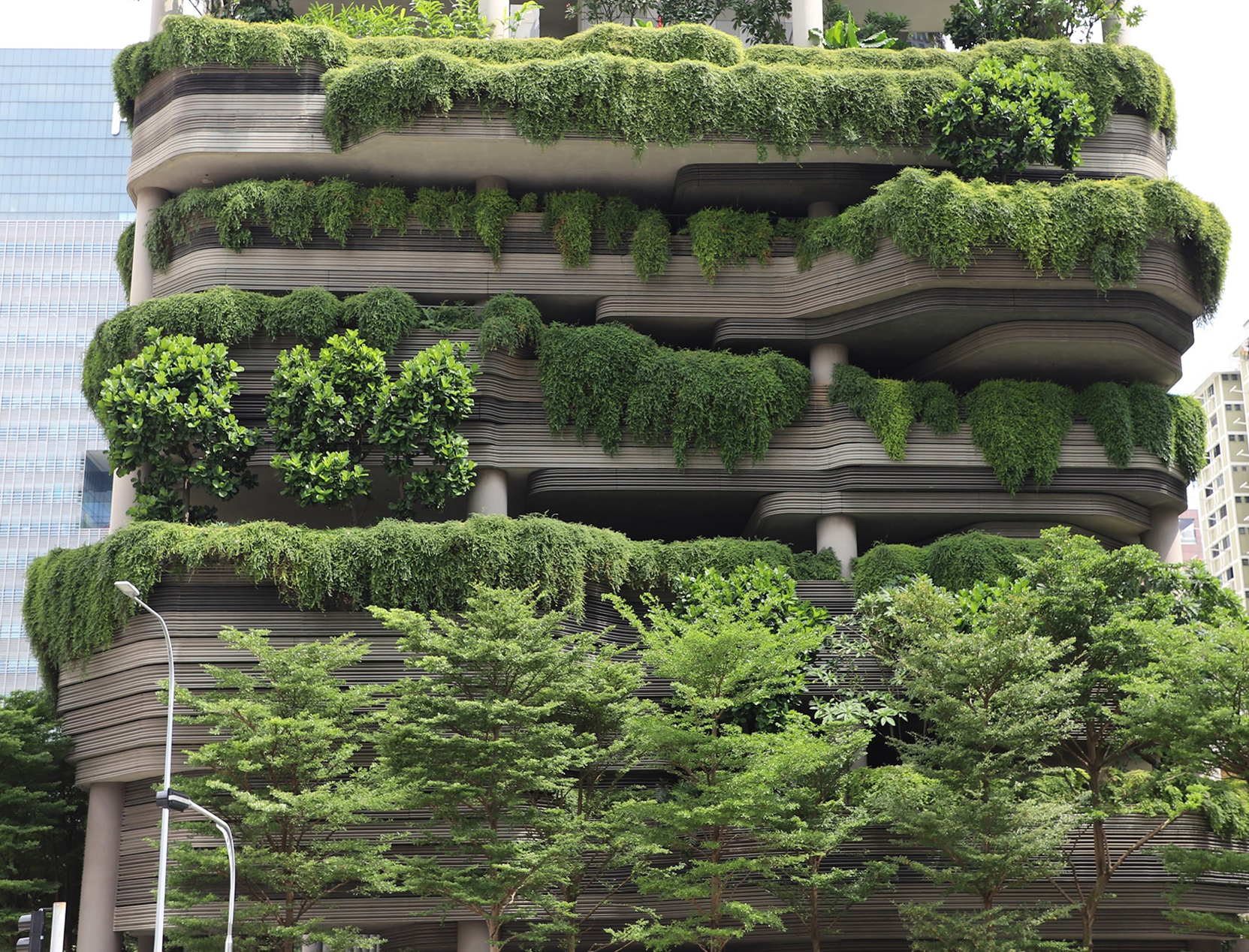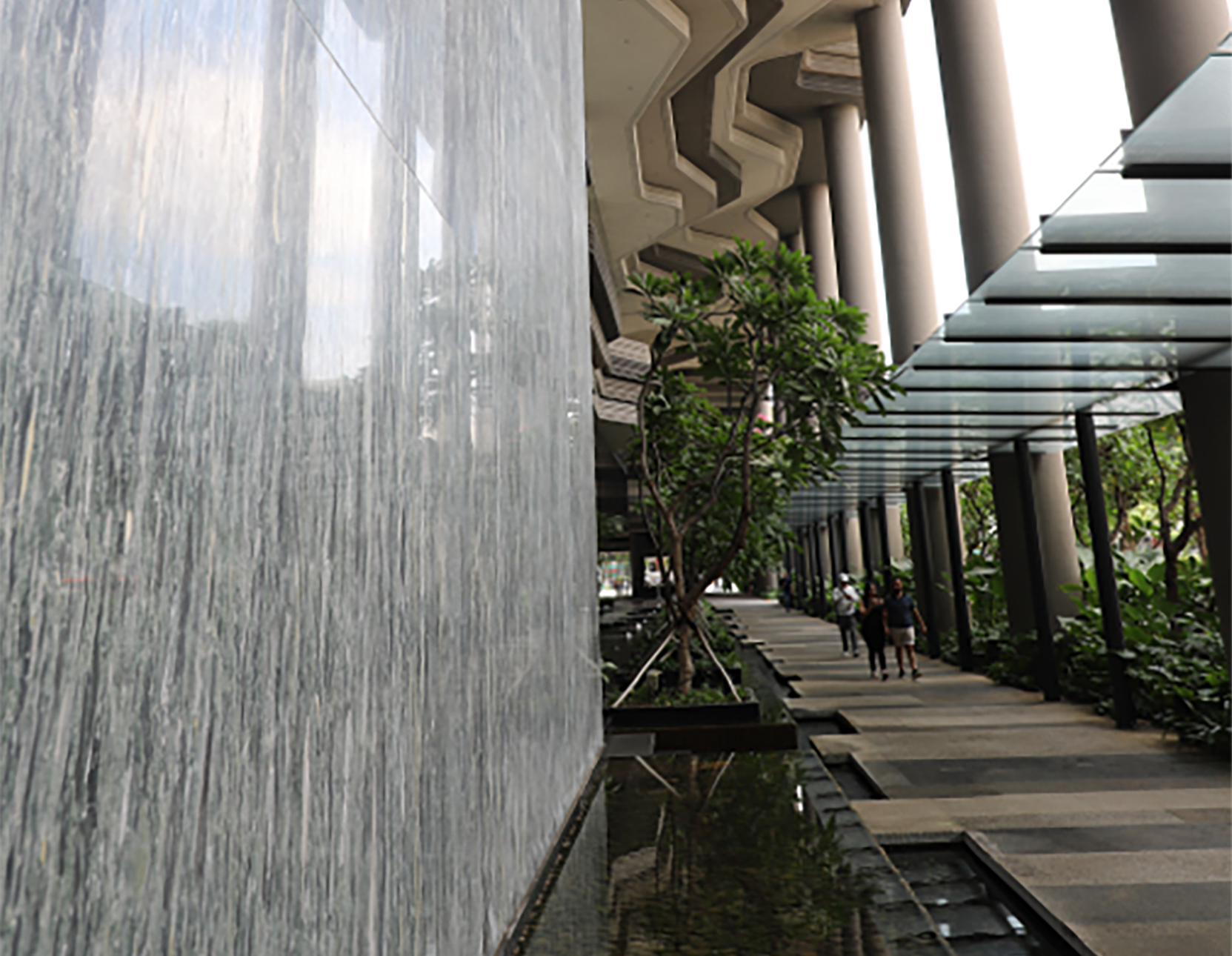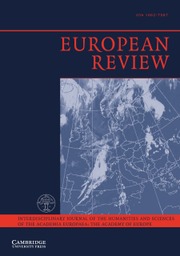Introduction
Nature-Based Solutions (NBS) enhance urban resilience and contribute to climate neutrality by tackling biodiversity decline and fostering sustainable infrastructure. Incorporated with renewable energy systems and circular economy approaches, NBS support initiatives such as the EU Mission ‘100 Climate-Neutral and Smart Cities’, which focuses on emission reductions, energy efficiency and sustainable transportation (European Commission 2020; 2021a). This article examines how Nature-Based Solutions and other urban innovations drive the green transition by integrating ecological, social, aesthetic and technological aspects, reducing emissions, enhancing biodiversity and supporting sustainable urban mobility (European Commission 2020; 2021b, 2022). Digital Twins, such as Singapore’s ‘Virtual Singapore’, utilize internet-of-things (IoT) sensors for real-time solutions, complemented by living laboratories that test scalable innovations such as permeable pavements for urban resilience (Monteiro et al. Reference Monteiro, Santos, Matos and Sá2024). The path towards achieving climate neutrality requires developing comprehensive solutions to such vital challenges as energy independence and switching to renewable energy sources, increasing the number of renovations of existing buildings and unlocking the full potential of the circular economy in relation to urban resources. Sustainable mobility directly reduces greenhouse gas (GHG) emissions and improves urban liveability. Electric buses in Shenzhen cut CO2 emissions by 48%, saving on fuel and maintenance costs (European Commission 2021a). Rotterdam’s hydrogen-powered public transport exemplifies a transformative strategy, using surplus solar and wind energy to produce green hydrogen through electrolysis, significantly reducing CO2 emissions and linking renewable energy production with decarbonized mobility. This approach integrates intermittent renewable energy with stable, low-emission transportation systems, contributing to climate neutrality goals (Dorst et al. Reference Dorst, van der Jagt, Raven and Runhaar2019). The stored hydrogen powers fuel cells, which produce only water vapor as exhaust, effectively eliminating CO2 and reducing air pollutants compared with diesel buses. The integration of renewable energy and clean mobility directly supports progress towards climate neutrality. Integration of public transport and bicycles is associated with the mobility as a service platform (MaaS) to minimize urban congestion and support the goal of reducing carbon dioxide (Rahimi Reference Rahimi, Khoramrou Dalake, Nobar, Tarashkar and Teymuri2024).
Urban Biodiversity and Ecosystem Restoration
Nature-Based Solutions, such as green roofs, urban forests, and wetlands, restore urban biodiversity by addressing ecological damage, improving air and water quality and supporting multi-scale ecological processes. Green roofs and habitat restoration collectively strengthen urban ecological resilience by enhancing biodiversity, improving water quality, stabilizing soils and increasing carbon storage (Viljanen et al. Reference Viljanen, Harju, Harmanen, Lähtinen and Toppinen2024). The urban forests, in turn, increase biodiversity by providing refuges, nesting sites and corridors for the movement of species, connecting isolated green areas to a more continuous habitat network. Urban wetlands reduce excess nutrients through vegetation absorption and microorganisms, decompose organic pollutants and improve water quality. This reduces nitrogen and phosphorus loads on urban waterways, reduces harmful algae blooms and improves aquatic health (Goodwin Reference Goodwin, Olazabal, Castro and Pascual2025). Urban biodiversity projects restore ecological balance, provide recreational areas that improve health and strengthen the city’s ability to adapt to climate challenges. City planning centred on the community promotes inclusiveness, social cohesion and acceptance of sustainable interventions. For example, Vienna’s Aspern Smart City actively involves residents in designing public spaces, merging cultural heritage with energy-efficient solutions (Schellnhuber et al. Reference Schellnhuber, Widera, Kutnar, Organschi and Hafner2022). Such participatory approaches not only improve ecological conditions and mental well-being but have also demonstrated quantifiable benefits, such as a 42% reduction in CO2 emissions and strengthened community ties (Golda-Pongratz Reference Golda-Pongratz2021). Vertical Green Systems (VGS), which combine vegetation with shading structures, reduce urban heat islands by lowering ambient temperatures through evapotranspiration (Figure 1). VGS enhance biodiversity through carbon dioxide absorption and habitat creation for pollinators while efficiently adjusting to seasonal changes in sunlight and wind (Chojnacka et al. Reference Chojnacka, Widera and Macarulla2024). Appropriate VGS design considers adequate orientation of the façade to cardinal directions correlated with suitable plants selection, shading strategies, such as passive and kinetic shields and organic fertilizers supporting plants’ resilience (Chojnacka et al. Reference Chojnacka, Widera and Macarulla2024). The transformative potential of green roofs and façades represents a crucial strategy for low-carbon development and climate neutrality of EU cities. Furthermore, smart irrigation technologies, powered by renewable energy and equipped with soil moisture sensors, optimize water use, improving plant health while conserving resources. Smart irrigation systems powered by renewable energy lower greenhouse gas emissions by reducing the energy required for air conditioning in urban buildings (Viljanen et al. Reference Viljanen, Harju, Harmanen, Lähtinen and Toppinen2024). The Academia Europaea Smart & Resilient City Excellence Hub fosters cross-disciplinary collaboration by integrating environmental science, architecture and technology. Several urban innovations such as permeable pavements and cooling corridors are piloted in living laboratories, leveraging real-time climate data and predictive analytics to address challenges such as flooding, heatwaves and urban heat islands (European Environment Agency 2024). Urban planners can develop and scale effective, adaptable solutions through cross-disciplinary collaboration.

Figure 1. Vegetated green systems designed by WOHA Architects in Parkroyal Hotel on Pickering, Singapore, 2015. Photo by B. Widera (2024).
Climate Neutrality and Adaptation to Climate Change in Urban Areas of Europe
Decarbonization of European cities by 2030 requires synchronized urban planning, stakeholder participatory engagement and the effective implementation of cutting-edge technologies. Cities such as Copenhagen and Rotterdam serve as models for the EU Mission ‘100 Climate-Neutral and Smart Cities’ by executing climate action strategies centred on renewable energy, sustainable transportation and urban biodiversity. The mission supports cities in developing and implementing comprehensive climate action plans, focusing on reducing carbon emissions, enhancing energy efficiency and promoting sustainable urban mobility. The mission also encourages the adoption of NBS to achieve climate neutrality and improve urban resilience (European Commission 2020). Additionally, the integration of renewable energy sources and circular economy practices plays a crucial role in minimizing environmental impacts and fostering economic resilience (Dorst et al. Reference Dorst, van der Jagt, Raven and Runhaar2019). Collaborative efforts among local authorities, industries, and communities are essential to overcome barriers and drive innovation, ensuring that urban centres can effectively contribute to the EU’s decarbonization goals by 2030 (Urrutia-Azcona et al. Reference Urrutia-Azcona, Tatar, Molina-Costa and Flores-Abascal2020). Decentralized renewable energy systems, such as solar microgrids coupled with battery storage, ensure energy resilience during extreme weather. For instance, Barcelona’s solar microgrids supply power to critical infrastructure while reducing reliance on centralized systems (European Commission 2020).
Strategies for Climate Resilience in Urban Areas of Europe
The EU Mission ‘Adaptation to Climate Change’ advocates incorporating NBS into urban planning to enhance resilience against extreme weather events, for instance through expanded green spaces and improved water management (Atanasova et al. Reference Atanasova, Castellar and Pineda-Martos2021). The objective is to establish a network of resilient urban areas that can effectively tackle climate change by encouraging cooperation between cities, researchers and policymakers (European Commission 2020). Climate resilience strategies in European cities focus on improving their adaptability, including the adoption of green infrastructure, the encouragement of sustainable urban transportation and the construction of energy-efficient structures (Dorst et al. Reference Dorst, van der Jagt, Raven and Runhaar2019). It is critical to improve urban resilience to climate change, especially due to extreme climate events such as floods, droughts and heat waves. The initial European Climate Risk Assessment (EUCRA) noted that Europe is the world’s fastest-growing continent, having warmed at about twice the global average since the 1980s (European Environment Agency 2024). With changing precipitation patterns, southern areas will experience significant water shortages, while other regions will face repeated landslides, mudslides or flooding following intense rainfall (European Commission 2024). Climate change represents a major threat to Europe’s built environment and infrastructure, carrying considerable consequences for human health and well-being. Significant changes in the minimum requirements on structural design in the EU, integrating climate adaptation and resilience, will be necessary, and are already foreseen as an update of the standards (Eurocodes) of buildings (European Commission 2024). In particular, it will be mandatory to consider the future climate hazards on structures of buildings.
Nature-Based Solutions reduce urban vulnerability to climate impacts while building resilience (Melanidis and Hagerman Reference Melanidis and Hagerman2022). For instance, NBS for natural cooling in urban areas, such as evaporative cooling and outdoor wind corridors, play a crucial role in reducing vulnerability to climate change and enhancing resilience and human safety (Widera Reference Widera2023). The strategic placement of water bodies and green spaces lowers ambient temperatures by utilizing the natural process of water evaporation, which absorbs heat from the environment (Soltanifard Reference Soltanifard2024) (Figure 2). Outdoor wind corridors, created by aligning streets and open spaces to facilitate natural airflow, help disperse heat and pollutants, improving air quality and thermal comfort (Rahimi et al. Reference Rahimi, Khoramrou Dalake, Nobar, Tarashkar and Teymuri2024). Integrating NBS into urban planning directly reduces cities’ climate-related vulnerabilities and enhances their overall resilience (Melanidis and Hagerman Reference Melanidis and Hagerman2022). NBS operate through fundamental ecological and physical processes. For instance, when water held in vegetation, soils or open water surfaces evaporates, it absorbs latent heat from the environment, thereby dissipating thermal energy and mitigating the urban heat island effect (Soltanifard Reference Soltanifard2024). As a result, surrounding areas experience lower peak temperatures, decreasing heat-related health risks and reducing the energy demand for air conditioning in adjacent buildings. Prioritizing permeable urban infrastructure, such as pavements and bioswales, is essential for effective flood management. Such approaches retain stormwater, recharge aquifers and lower flooding risks, particularly in densely populated areas (Goodwin et al. Reference Goodwin, Olazabal, Castro and Pascual2025). While climate resilience strategies focus on reducing the vulnerability to extreme weather events, renewable energy and circular economy practices complement these efforts by addressing the root causes of emissions and fostering long-term sustainability. In heat-vulnerable areas, reflective surfaces on roads and rooftops reduce local temperatures by reflecting solar radiation (Rahimi et al. Reference Rahimi, Khoramrou Dalake, Nobar, Tarashkar and Teymuri2024). Combined urban cooling strategies improve air quality and reduce summer temperatures by up to 2°C (Rahimi et al. Reference Rahimi, Khoramrou Dalake, Nobar, Tarashkar and Teymuri2024; Soltanifard Reference Soltanifard2024; Monteiro et al. Reference Monteiro, Santos, Matos and Sá2024; Widera Reference Widera2023).

Figure 2. Outdoor ventilation corridors with evaporative cooling designed by WOHA Architects in Parkroyal Hotel on Pickering, Singapore, 2015. Photo by B. Widera (2024).
Renewable Energy and Circular Economy
Renewable energy and circular economy innovations are critical for achieving climate-neutral cities. The adoption of renewable energy sources, such as solar and wind power, reduces greenhouse gas emissions and promotes energy independence. Incorporating rooftop solar photovoltaics (PV) and onshore wind turbines into urban energy systems replaces fossil fuels with renewable alternatives, significantly reducing carbon emissions. For example, Copenhagen’s energy strategy integrates district heating with wind and solar to achieve carbon neutrality by 2025 (European Commission 2020). The decentralized production of solar power, combined with energy storage solutions, stabilizes local grids, ensuring that electricity remains available during peak demand or extreme weather events. This technological shift mitigates carbon footprints and strengthens urban energy security.
Combining renewable energy with circular material flows lowers carbon emissions, bolsters green industries and builds economic resilience against resource shortages and price instability. Circular economy practices reduce environmental burdens by extending the life cycles of materials and products. The AdaptAction Program channels resources to NBS in climate-vulnerable urban areas, addressing adaptation and equity challenges (Swann et al. Reference Swann, Blandford, Cheng, Cook, Miller and Barr2021). Such funding models ensure targeted resource allocation and scalable urban innovations. Innovative funding mechanisms bridge the gap between conceptual and implemented urban solutions. Amsterdam’s Buiksloterham Circular District, funded through Horizon Europe, demonstrates modular construction and material-sharing economies (Urrutia-Azcona et al. Reference Urrutia-Azcona, Tatar, Molina-Costa and Flores-Abascal2020). Amsterdam’s circular economy initiatives enhance material reuse and recycling efficiency, significantly reducing waste and environmental impact. Material Passports – digital records tracking the composition and condition of building components – enable high-quality recycling, remanufacturing or direct reuse at the end of a structure’s life cycle (Urrutia-Azcona et al. Reference Urrutia-Azcona, Tatar, Molina-Costa and Flores-Abascal2020). This approach lowers resource extraction pressures, minimizes landfill waste and preserves embodied energy.
Bio-based construction materials, such as mycelium bricks, are renewable, biodegradable and have lower embodied carbon compared with traditional materials (Chojnacka et al. Reference Chojnacka, Widera and Macarulla2024). Mycelium bricks integrate fungal mycelium with agricultural by-products, forming durable, biodegradable blocks. Urban mining complements this by reclaiming reusable materials from old buildings, fostering local material-sharing economies.
Some of successful examples of urban innovations, already applied in European cities, include:
-
Barcelona’s Superblocks: A model of sustainable neighbourhoods with 42% lower CO2 emissions and improved community engagement.
-
Paris’s 15-Minute City: Prioritizing accessibility and reducing transport emissions by integrating essential services within walking or cycling distance.
-
Milan’s Bosco Verticale: Vertical forests absorbing 30 tons of CO2 annually while enhancing biodiversity.
-
Copenhagen’s Retention Parks: Combining flood management with beautiful, functional green spaces.
The New European Bauhaus and Cultural Dimensions of Urban Innovation
The cultural dimensions of urban innovation highlight the importance of community engagement and inclusivity in the green transition. The New European Bauhaus (NEB) initiative promotes the creation of beautiful spaces, accepted by society and contributing to the holistic transformation of the built environment, with a particular focus on the renovations of the EU building stock that enhance the quality of life for urban residents (European Commission 2021c). Successful urban innovations integrate cultural heritage with sustainable design to meet local needs. Projects such as the Vienna Aspern Smart City integrate cultural heritage preservation with modern energy-efficient designs, demonstrating how tradition and innovation can coexist to enhance urban life (Schellnhuber et al. Reference Schellnhuber, Widera, Kutnar, Organschi and Hafner2022). This multiplies environmental benefits, fostering community pride and alignment with the NEB vision of green transformation reflecting local identity. This synergy ensures not only improved environmental performance but also enhanced social cohesion and a sense of belonging (Schellnhuber et al. Reference Schellnhuber, Widera, Kutnar, Organschi and Hafner2022). The New European Bauhaus incorporates NBS and innovative design to create resilient, sustainable and vibrant urban spaces (Schellnhuber et al. Reference Schellnhuber, Widera, Kutnar, Organschi and Hafner2022). The cultural dimension of urban innovation aligns with the New European Bauhaus’ focus on inclusiveness and aesthetics.
Conclusions
Nature-Based Solutions and urban innovations drive the green transition by reducing emissions, improving biodiversity and enhancing resilience. Cross-disciplinary collaboration and real-time data analytics enable cities to implement scalable solutions, addressing climate challenges and creating sustainable, inclusive urban environments. The Academia Europaea Smart & Resilient City Excellence Hub will accelerate climate action by implementing scalable, actionable solutions for EU cities. This Hub should act as a platform for cross-disciplinary collaboration, integrating environmental science, architecture and technology to scale Nature-Based Solutions. Linking real-time climate data with predictive analytics, urban planners can anticipate and mitigate risks, ensuring cities remain adaptable and resilient. The initiatives will catalyse the EU’s transition toward greener, more inclusive urban landscapes.
About the Authors
Katarzyna Chojnacka is a full professor at Wrocław University of Science and Technology and Chair of the Department of Advanced Materials Technologies. Her research explores innovative approaches to nutrient recovery and recycling from biowaste, with a focus on circular economy applications in agriculture. She has authored over 350 peer-reviewed publications on biosorption, bioaccumulation, and sustainable fertilizer production. Her work has contributed to the development of bio-based materials for environmental applications. She is a Member of Academia Europaea.
Barbara Widera is a professor at Wrocław University of Science and Technology and an expert in sustainable architecture and urban design. Her work explores nature-based solutions, climate-resilient urban development, and circular design in the built environment. She co-chaired the Urban Innovations Panel at Academia Europaea conferences.



